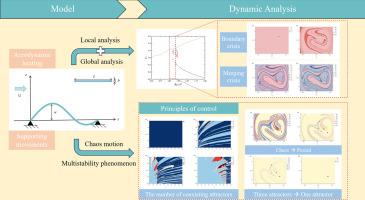Global dynamics and multistability control of heated panel in supersonic flow
IF 4.4
2区 工程技术
Q1 ENGINEERING, MULTIDISCIPLINARY
引用次数: 0
Abstract
This study investigates the global dynamics of a heated, simply supported panel in supersonic flow with structural nonlinearity and support motion. The governing equations, derived using von Kármán’s large deflection theory and first-order piston theory, are discretized into ordinary differential equations via Galerkin’s method. Using the composite cell coordinate cystem (CCCS) method for global analysis, we identify that variations in excitation amplitude and thermal stress trigger three critical transitions: boundary, interior, and merging crises, inducing multistability with interlaced basins of attraction. The multistability property increases the system’s sensitivity to perturbations, threatening the panel’s safe service. To address this, we first established a mapping between excitation parameters and the number of coexisting attractors, and then presented a control strategy. Numerical simulation results show that the strategy successfully eliminates coexisting attractors and can even convert chaotic motion into periodic orbits. Our findings provide novel insights into the nonlinear dynamics of panels in supersonic flow and establish a theoretical basis for the control of multistability.

加热板在超音速流动中的全局动力学及多稳定控制
本文研究了具有结构非线性和支撑运动的加热简支板在超音速流动中的整体动力学问题。利用von Kármán的大挠度理论和一阶活塞理论导出的控制方程,通过伽辽金方法离散为常微分方程。利用复合胞元坐标系(CCCS)方法进行全局分析,我们发现激发振幅和热应力的变化触发了三个关键转变:边界危机、内部危机和合并危机,导致了相互交错的吸引力盆地的多稳定性。多稳定性增加了系统对扰动的敏感性,威胁到面板的安全使用。为了解决这个问题,我们首先建立了激励参数与共存吸引子数量之间的映射关系,然后提出了一种控制策略。数值仿真结果表明,该策略成功地消除了共存吸引子,甚至可以将混沌运动转化为周期轨道。我们的研究结果为研究超声速流动中板的非线性动力学提供了新的见解,并为控制多稳定性奠定了理论基础。
本文章由计算机程序翻译,如有差异,请以英文原文为准。
求助全文
约1分钟内获得全文
求助全文
来源期刊

Applied Mathematical Modelling
数学-工程:综合
CiteScore
9.80
自引率
8.00%
发文量
508
审稿时长
43 days
期刊介绍:
Applied Mathematical Modelling focuses on research related to the mathematical modelling of engineering and environmental processes, manufacturing, and industrial systems. A significant emerging area of research activity involves multiphysics processes, and contributions in this area are particularly encouraged.
This influential publication covers a wide spectrum of subjects including heat transfer, fluid mechanics, CFD, and transport phenomena; solid mechanics and mechanics of metals; electromagnets and MHD; reliability modelling and system optimization; finite volume, finite element, and boundary element procedures; modelling of inventory, industrial, manufacturing and logistics systems for viable decision making; civil engineering systems and structures; mineral and energy resources; relevant software engineering issues associated with CAD and CAE; and materials and metallurgical engineering.
Applied Mathematical Modelling is primarily interested in papers developing increased insights into real-world problems through novel mathematical modelling, novel applications or a combination of these. Papers employing existing numerical techniques must demonstrate sufficient novelty in the solution of practical problems. Papers on fuzzy logic in decision-making or purely financial mathematics are normally not considered. Research on fractional differential equations, bifurcation, and numerical methods needs to include practical examples. Population dynamics must solve realistic scenarios. Papers in the area of logistics and business modelling should demonstrate meaningful managerial insight. Submissions with no real-world application will not be considered.
 求助内容:
求助内容: 应助结果提醒方式:
应助结果提醒方式:


